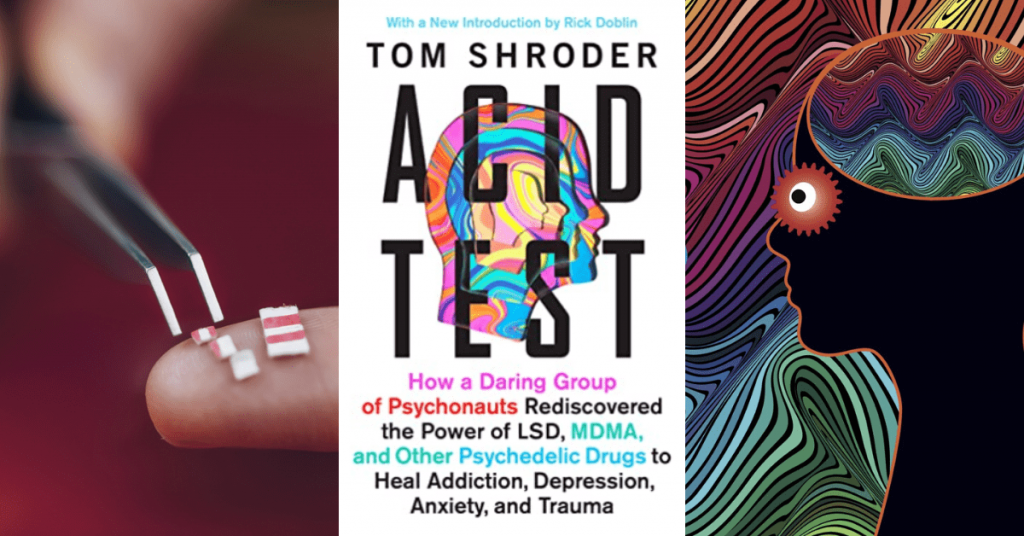Themanummer over psychedelica in ‘The Psychologist’
Recentelijk heeft de Britse Psychological Association een speciaal themanummer van ´The Psychologist´ (September 2014, vol. 27) aan de toenemende populariteit van onderzoek naar psychedelica gewijd. Dit is de eerste keer dat er een uitgebreide publicatie over de complexiteit van de psychedelische ervaring verscheen in het blad.
David Nutt (2014) stelt, in het eerste artikel van het nummer, dat de wetenschappelijke desinteresse van het verleden verklaard kan worden door de maatschappelijke poging om psychedelica van hun “waarde en belang” te ontdoen om morele redenen. De politieke redenering gaat als volgt: hoe kunnen we anders dan het onderzoek naar psychedelica veroordelen wanneer het risico bestaat dat dit onderzoek recreatief gebruik zou kunnen legitimeren? Ondanks de mogelijke maatschappelijke risico’s stelt Nutt dat “het falen van de wetenschappelijke gemeenschap (met name neurowetenschappers) om te protesteren tegen het verbod op onderzoek naar hallucinogenen, één van de meest ontstellende vergissingen van de laatste eeuw is, en dat die ongedaan moet worden gemaakt. Psychologen en andere neurowetenschappers moeten het recht opeisen om deze drugs te bestuderen” (2014).
Vele neurowetenschappers hebben niet gewacht tot Nutt met deze oproep kwam om te beginnen met het ontrafelen van de relatie tussen psychedelische drugs en de menselijke hersenen. In How do psychedelics work on the brain? (het tweede artikel) beschrijven Carhart-Harris, Kaelen en Nutt (2014) de psychedelische ervaring, beginnend bij het niveau van neurotransmitters en eindigend bij de grootschalige neuronale systemen in het brein. De voor de hand liggende vraag voor de psychologie (zoals aangegeven in de titel van het themanummer) is of de neuronale dimensie ons iets kan vertellen over de psychedelische ervaring dat nog binnen ons gebied van betekenis ligt, of zoals Jameson het stelt, “our cognitive mapping” (1991).
In het derde artikel neemt Vaughan Bell (2014) een andere invalshoek en stelt hij de vraag: wat kunnen we leren uit de manieren waarop andere culturen omgaan met hallucinogene drugs? Bell stelt dat “drugs-geïnduceerde hallucinaties vaak worden onderzocht alsof ze volledig kunnen worden begrepen als chemische reacties in het brein”. In Bell’s gedachtegoed is het niet in het brein, maar juist in de cultuur en de relatie tussen het individuele en de sociale context waar de interessante effecten plaatsvinden.
Het vierde artikel, geschreven door Henry David Abraham (2014), verbindt de drie eerdere artikelen door het onderzoek van de auteur naar HPPD (hallucinogen persisting perception disorder) te beschrijven. Abraham geeft hierin een fenomenologische beschrijving van de complexe dynamiek tussen de neuronale en de psychologische dimensies van HPPD.
Charles Grob, Ira Byock en Erica Rex breiden, in het vijfde artikel Viewpoints: Experiences of hallucinogen treatment (2014), de denkwijze van Abraham uit door inzicht te geven in het ‘nieuwe’ veld van psychedelische therapie. “Verschillende deelnemers”, zegt Byock, “rapporteren niet alleen een vermindering van angst of depressie, maar ook een langdurig gevoel van welzijn. Sommigen uiten een gevoel van vrede, dankbaarheid voor hun leven, vergiffenis naar anderen en naar henzelf, en minder angst en meer zekerheid over de toekomst”. De door Grob beschreven behandelinterventie voor “existentiële angst” wordt gezien als slechts een van de vele mogelijke toepassingen van psychedelica.
Alle artikelen zijn in de september editie van The Psychologist verschenen (volume 27, 9) “A brave new world for psychology?”
Referenties
Abraham, H. D. (2014). When the trip doesn’t end. The Psychologist, 27(9), 670-673.
Bell, V. (2014). Cultures of chemically induced hallucinations. The Psychologist, 27(9), 666-669.
Carthart-Harris, R., Kaelen, M., & Nutt, D. (2014). How do hallucinogens work on the brain? The Psychologist, 27(9), 662-665.
Grob, C.S., Byock, I.R., Rex, E. (2014). Viewpoints: Experiences of hallucinogen treatment. The Psychologist, 27(9), 676-679
Jameson, F. (1991). Postmodernism, or, the cultural logic of late capitalism. Durham, NC: Duke University Press.
Nutt, D. (2014). A brave new world for psychology? The Psychologist, 27(9), 658-661.
Themanummer over psychedelica in ‘The Psychologist’ Read More »

 De resultaten van een
De resultaten van een 
 The Psilocybin Research Team at Johns Hopkins needs your help! To study the complex, and often challenging experiences usually referred to as ´bad trips´, the Psilocybin Research Team is conducting an anonymous, web-based survey into this very phenomena. If you’ve ever had such an experience, they would greatly appreciate it if you participate. Also if you know anyone that has had such an experience and would be interested in participating, don’t hesitate to pass on the link.
The Psilocybin Research Team at Johns Hopkins needs your help! To study the complex, and often challenging experiences usually referred to as ´bad trips´, the Psilocybin Research Team is conducting an anonymous, web-based survey into this very phenomena. If you’ve ever had such an experience, they would greatly appreciate it if you participate. Also if you know anyone that has had such an experience and would be interested in participating, don’t hesitate to pass on the link. It’s no secret that psychedelic drugs have the ability to cast light on the miraculous reality hidden within our psyche. Almost immediately after the discovery of LSD less than a hundred years ago, psychedelics began to play a crucial role in the quest to understand the link between mind and matter. With an uncanny ability to reveal the mind’s remote frontiers and the unmapped areas of human consciousness, LSD and MDMA (better known as Ecstasy) have proven extraordinarily effective in treating anxiety disorders such as PTSD—yet the drugs remain illegal for millions of people who might benefit from them.
It’s no secret that psychedelic drugs have the ability to cast light on the miraculous reality hidden within our psyche. Almost immediately after the discovery of LSD less than a hundred years ago, psychedelics began to play a crucial role in the quest to understand the link between mind and matter. With an uncanny ability to reveal the mind’s remote frontiers and the unmapped areas of human consciousness, LSD and MDMA (better known as Ecstasy) have proven extraordinarily effective in treating anxiety disorders such as PTSD—yet the drugs remain illegal for millions of people who might benefit from them.